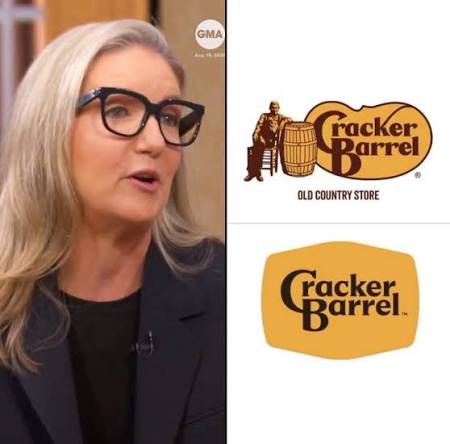Introduction — From Biscuits to Bankruptcy Vibes
Cracker Barrel once stood for hokey Americana comfort — rocking chairs out front, hash-brown casserole inside, and a gift shop that looked like your great-aunt’s garage sale exploded.
That was then. Now it’s a corporate blooper reel with the volume stuck on max.
Everywhere you look, the place is bleeding out credibility. Customers are dunking on the food, employees are sketching scenes of chaos, and investors are waving red flags like they’re flagging down a runaway tour bus. Meanwhile, management insists everything is fine — that the company is “transforming.” It’s the absurdity Camus described: endless labor performed without meaning, only here it’s served on a plate with cold biscuits [1].
⸻
Act I — The CEO Who Couldn’t Lead Herself Out of a Gift Shop
Julie Felss Masino arrived as Cracker Barrel’s supposed savior, haloed by her Taco Bell résumé [2]. But fast-food glory doesn’t translate to family dining. At Taco Bell, a mistake means you ruin a $1.29 taco. At Cracker Barrel, you ruin someone’s childhood memories.
Her leadership has turned “rebranding” into a four-letter word. The $700 million makeover meant to modernize the chain produced the now-infamous logo fiasco — a redesign so bland and tone-deaf that customers revolted. Within days, social media had roasted it into ash. Masino was forced to issue a public apology [3][14], promising to “listen and learn.” That phrase — corporate for “please stop yelling at us online” — became the chain’s accidental slogan.
The embarrassment didn’t stop there. One of Cracker Barrel’s own co-founders emerged to deliver the coup de grâce, telling Fox Business that Masino “knows very little about the company” and that the leadership team has “lost touch with what made Cracker Barrel Cracker Barrel” [13]. When your founder publicly implies the CEO doesn’t understand biscuits, it’s not a leadership challenge; it’s an existential crisis.
The investor community noticed. One of the company’s largest stakeholders issued four formal warnings about leadership failures [4], while a proxy advisory firm handed out a failing grade for pay-for-performance [5]. Translation: they were paying arena-rock salaries for county-fair results.
Inside the company, morale cratered. Employees describe a top-heavy structure where every solution is a PowerPoint and every promise evaporates. “Everything is about spin at the top while stores are on life support,” one worker wrote [6]. Another said bluntly, “We don’t need slogans or another logo — we need staff in the kitchen.”
To make matters worse, Masino’s own training videos were quietly scrubbed from the corporate network [7]. When even your internal brand evangelism is memory-holed, you’re not inspiring confidence; you’re erasing evidence.
By fall 2025, the story had metastasized. Between the co-founder’s public rebuke, the apology tour, and the collapse of employee trust, Cracker Barrel’s “strategic transformation” looked less like reinvention and more like self-immolation. The only transformation happening was from beleaguered restaurant chain to case study in corporate hubris.
⸻
Act II — The Board of Directors — Rubber Stamps in Rocking Chairs
If Masino is the head clown in this circus, the board is the silent mime troupe nodding along while the tent burns down. Their supposed duty is to protect shareholder value; instead, they’ve acted like an HOA approving new shrubbery while the house catches fire.
Those same investor warnings [4] should have jolted them awake. Instead, they hit snooze. They watched customer sentiment nosedive, employees beg for support, and brand identity implode into a marketing deck [8]. Oversight? Negligence wrapped in corporate jargon.
That failing-grade report from the proxy firm [5] wasn’t just an indictment of management; it was a neon sign flashing BOARD FAILURE. Who approves the golden parachutes and “performance bonuses” for executives presiding over decline? The same directors who will later feign surprise when investors ask why their strategic vision keeps driving into a ditch.
Fox Business detailed how the pay-for-performance mismatch persisted even after multiple quarters of sliding sales, yet the board continued to authorize compensation packages that would embarrass Silicon Valley [5]. They have turned accountability into a quaint relic, like the checkerboard on the front porch: nice to look at, but nobody’s actually playing.
On Reddit, staff describe skeleton crews and management gaslighting them about “efficiency initiatives” [6]. Customers describe hour-long waits and cold plates. The board’s answer? Another round of executive bonuses for “navigating challenging conditions.” It’s not oversight — it’s complicity.
At this point, the board isn’t just failing to lead; it’s actively enabling the decline. The rocking chairs in the boardroom may as well be empty, because they’re contributing exactly that much.
Act III — Employees & Customers: The Ones Left Holding the Biscuit
To understand Cracker Barrel’s collapse, skip the investor decks and go straight to r/CrackerBarrel, where servers, cooks, and managers describe a reality the board pretends doesn’t exist. Broken fryers, impossible schedules, apathetic district managers — a daily slog closer to Catch-22 than hospitality.
One employee wrote: “Everything’s about optics at the top. We’re drowning, and they’re rearranging décor.” Another: “We don’t need slogans or another logo. We need a dishwasher that works.” [6]
Then came The New York Post’s September exposé: “Kitchens in Turmoil” [16]. Food scandals, expired ingredients, chaos in prep lines — the kind of details that make diners gag and investors cringe. Employees described walking into kitchens that looked “like a battlefield” after management cuts staff and corners at the same time. “They tell us to smile,” one said, “but it’s hard to smile when the fryer oil looks like black coffee.”
Customers have noticed. Online reviews sound less like feedback and more like survivor testimony. One diner quipped, “The gift shop’s the best part now — because at least it still works.”
It’s tragicomic: employees condemned to roll the same stone uphill — underpaid, understaffed, under-listened-to — while management congratulates itself for “efficiency.” Camus would call it absurd. Dostoyevsky might call it cruel.
⸻
Act IV — Investors & Markets: When the Money Walks Away
Wall Street doesn’t care about nostalgia; it cares about returns. And right now, Cracker Barrel looks like a bad bet on comfort food. Investors have gone from worried to furious.
Yahoo Finance chronicled four public investor warnings [4], and still the board did nothing. Stock performance sagged after the company had to walk back its rebrand and remodel plans [10]. Even Parade Magazine — not exactly a financial watchdog — reported closures of 14 Maple Street Biscuit Company locations, a costly side hustle Masino once touted as “the future” [15]. You can’t pivot to the future if you keep locking the doors behind you.
Then came the proxy bomb: an SEC filing detailing activist shareholder efforts to remove key directors [17]. It reads like a manifesto from people tired of watching their equity drown in gravy. The filing cites “repeated operational failures, poor capital allocation, and loss of brand equity.” In corporate terms, that’s a no-confidence vote.
And while the board fiddled, rival CEOs pounced. Steak ’n Shake’s Sardar Biglari — himself a polarizing figure — took public shots at Cracker Barrel’s leadership [9]. Cracker Barrel fired back with the subtlety of a cafeteria food fight, calling Biglari “self-interested.” Which was rich, coming from executives earning bonuses for losing market share.
Confidence is currency. Cracker Barrel has spent it all.
⸻
Act V — Culture & Perception: The Brand That Mocked Itself
Cracker Barrel used to be shorthand for Americana comfort. Now it’s shorthand for trying too hard.
The logo redesign was supposed to modernize the chain. Instead, it triggered one of the most spectacular online roastings in restaurant history. Memes spread faster than gravy, forcing Masino into a public apology [14]. Within days, she was in full retreat — “listening and learning” while the internet collectively asked who thought the logo looked like a midwestern car wash.
Even OutKick declared: “Cracker Barrel Admits Total Defeat.” [3] Customers didn’t see innovation; they saw desperation.
Meanwhile, the food — once reliable — has become punchline material. “Hashbrown casserole used to hit. Now it tastes like it was made by interns,” one customer wrote [6]. Even die-hards admit the biscuits are “indistinguishable from the table coasters.”
Online, Cracker Barrel has become its own meme: corporate nostalgia run through the meat grinder of bad decisions. Once, it sold comfort. Now, it sells irony.
⸻
Act VI — Conclusion: Burn the Rocking Chairs, Start Over
This isn’t bad luck; it’s failed leadership. The collapse of Cracker Barrel is the direct result of a CEO out of her depth, a board out of excuses, and a corporate culture allergic to reality.
The receipts are all here:
• A $700 million rebrand that crashed and burned [3][13][14].
• A co-founder publicly declaring the CEO “knows very little about the company” [13].
• Food scandals and staff turmoil [16].
• Store closures and retreat from expansion [15].
• A shareholder revolt formalized in an SEC filing [17].
• And a board still approving bonuses while pretending the porch lights aren’t flickering [5][8].
Cracker Barrel has become a Dostoyevskian farce — leadership trapped in contradictions of its own making, aware of the absurdity yet unwilling to change.
The fixes aren’t complicated but they are brutal:
Fire the CEO.
Fire the board.
Start over.
Anything less is rearranging rocking chairs on the deck of a sinking ship. The biscuits are cold, the investors are gone, and the staff have stopped believing in the brand.
The rocking chairs are empty. It’s time for management to join them.
⸻
Citations
1. Camus, Albert. The Myth of Sisyphus. (1942).
3. OutKick: “Cracker Barrel Admits Total Defeat in Latest Social Media Message.” (2025).
4. Yahoo Finance: “Top Investor Issued 4 Warnings.” (2025).
5. Fox Business: “Cracker Barrel Execs Earned Failing Grade from Proxy Advisory Firm.” (2024).
6. Reddit, r/CrackerBarrel — Employee & Customer Commentary Threads. (2025).
7. Reddit, r/CrackerBarrel — Reports of CEO Training Videos Removed. (2025).
8. Cracker Barrel Investor Relations: “Update on Strategic Transformation Plan.” (2024).
9. Fox Business: “Steak ’n Shake Fires Back After Cracker Barrel Swipes at Sardar Biglari.” (2025).
11. USA Today: “Steak ’n Shake Billboard Calls for Cracker Barrel CEO’s Firing.” (2025).
12. OutKick / Fox Business Coverage of Cracker Barrel Corporate Messaging. (2025).
14. The Street: “Cracker Barrel CEO Apologizes for Logo and Store Changes.” (2025).
15. Parade: “Cracker Barrel Closing 14 Maple Street Restaurants as Focus Shifts.” (2025).

